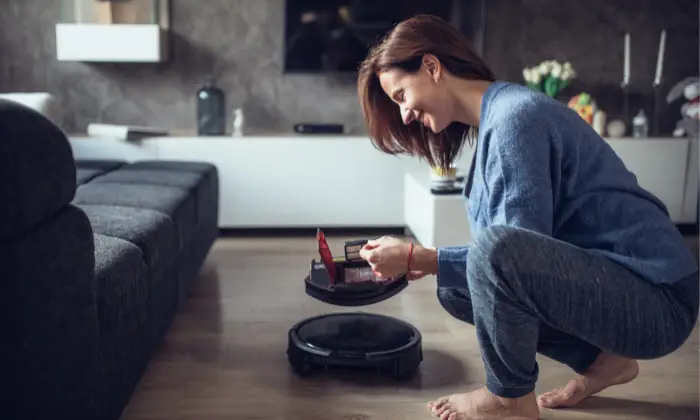
Fleas are a common problem – for pet owners and homeowners, but can fleas get out of vacuum cleaner? The truth is it depends on the type of vacuum cleaner and the stage of the flea’s life cycle.
In this blog post, we’ll take a closer look at the flea’s life cycle, the effectiveness of different types of vacuum cleaners, and tips for preventing and controlling flea infestations. Whether you’re a pet owner or want to keep your home flea-free, this is a must-read.
Keep reading to get all the information you need to vacuum fleas away for good.
The Life Cycle of Fleas

The life cycle of fleas is an important – factor to consider when trying to understand the potential for fleas to escape a vacuum cleaner. Fleas go through 4 stages in their life cycle: egg, larva, pupa and adult.
Adult fleas lay eggs on host animals like dogs and cats. The eggs hatch into small worm-like larvae that feed on organic debris. The larvae spin cocoons, develop into pupae, and then adult fleas emerge.
Understanding this life cycle is important because it helps us understand how some stages may be more protected from vacuum cleaners and the potential for new fleas to hatch even after a vacuuming session.
Can Fleas Get Out of Vacuum Cleaner?

When it comes to vacuuming and controlling flea infestations, the question of whether or not fleas can escape from a vacuum cleaner is important.
Unfortunately, the answer is complex, as it depends on various factors, including the type of vacuum cleaner and the stage of the flea’s life cycle.
Different types of vacuum cleaners have varying degrees of effectiveness in trapping fleas. For example, a traditional upright vacuum cleaner with a bag may not be as effective as a bagless vacuum cleaner with HEPA filters.
This is because the HEPA filter is able to trap tiny particles, including flea eggs and pupae, which are not easily trapped by traditional vacuums.
Even with a vacuum cleaner that is effective at trapping fleas, there is still a potential for fleas to escape through gaps or openings in the vacuum cleaner. For example, if a vacuum cleaner has a hole or tears in the hose, fleas may be able to escape through it.
Additionally, if the vacuum cleaner bag is not properly sealed or replaced when full, fleas may be able to escape through the open top.
Furthermore, even if adult fleas and larvae are vacuumed up, there is still the potential for flea eggs to hatch and develop into adults after being vacuumed up.
For example, if flea eggs are vacuumed up and then land on a warm, moist surface, they may still be able to hatch and develop into adults.
In conclusion, while vacuuming is an effective way to remove adult fleas and larvae, it may not be 100% effective in removing all stages of the flea’s life cycle or preventing new fleas from hatching after being vacuumed up.
It’s important to consider the type of vacuum cleaner, the maintenance of the vacuum, and flea prevention methods in conjunction with vacuuming for effective flea control.
Prevention and Control

Prevention and control of flea infestations involve a combination of methods, including:
- Regular vacuuming: using a vacuum cleaner with HEPA filters to remove adult fleas, larvae and debris.
- Flea and tick medication for pets: Use products like topical treatments, oral medications or collars that keep the fleas from attaching to your pet.
- Vacuum cleaner maintenance: ensuring that vacuum cleaner bags are properly sealed or replaced when full and checking for holes or tears in the vacuum cleaner hose.
- Flea sprays or powders: Treat carpets and upholstered furniture with flea sprays or powders to kill fleas and their eggs.
- It is preventing re-infestation: using a flea comb to remove fleas and eggs from pets, keeping the indoor and outdoor environment clean and treating pet bedding with insecticides.
- Consultation with a vet or professional exterminator for extreme cases of infestation.
Frequently Asked Questions:
Q: Can fleas survive in a vacuum cleaner?
Fleas can survive in a vacuum cleaner if they are not trapped by the filters and are able to escape through gaps or openings in the vacuum cleaner. Additionally, flea eggs and pupae may be able to survive the vacuuming process and hatch into adult fleas later. However, vacuuming is an effective way to remove adult fleas and larvae, but proper vacuum cleaner maintenance and using a vacuum cleaner with a HEPA filter can improve effectiveness and decrease the chance of fleas surviving.
Q: How many times should I vacuum to get rid of fleas?
Vacuuming every day is one way to get rid of fleas. Another way is to use a flea killer that is effective against both adult and juvenile fleas. You can also vacuum your home’s floors, furniture, and bedding. If you are using a vacuum cleaner with a bag, make sure to remove the bag after vacuuming to avoid leaving fleas behind.
Q: Can flea eggs be vacuumed up?
Flea eggs can be vacuumed up, but it is not always possible. Try vacuuming the areas where fleas are likely to be found, such as along the edges of furniture and under cushions. If you have a dog, vacuum their fur too. Do not use harsh chemicals or cleaners to clean your vacuum cleaner, as this can damage the motor.
Q: Can you get rid of fleas with a bagless vacuum?
There is a slight chance that you can get rid of fleas on a bagless vacuum, but it’s not always guaranteed. To kill fleas on a vacuum cleaner, you will need to vacuum up all the fleas and debris from the area. Make sure to close all the openings around the filter and hose, and do not use any harsh chemicals or cleaners on your vacuum cleaner.
Q: Does vacuuming itself kill fleas?
Vacuuming itself does not kill fleas. In fact, most fleas are killed when the pet is treated with an insecticide and then wears a flea collar. Fleas can only survive for about two weeks without their host (a pet), so using these three methods together is imperative to keep your home flea-free. Vacuuming should be performed after each pet’s treatment to prevent fleas from residence on the vacuum cleaner.
Conclusion
Vacuum cleaning can help control flea infestation and flea larvae in your home, but they can still get into your home if there is an entryway. Vacuuming thoroughly, treating areas where fleas are known to inhabit (such as pet bedding, cracks and crevices, and baseboards) and using insecticidal sprays or foggers around the home can help prevent fleas from entering the home.
You can also try sealing entry points like windows and doors with caulk to prevent fleas from getting inside. Further, use a vacuum cleaner that is capable of removing fleas from your vacuum bag.





